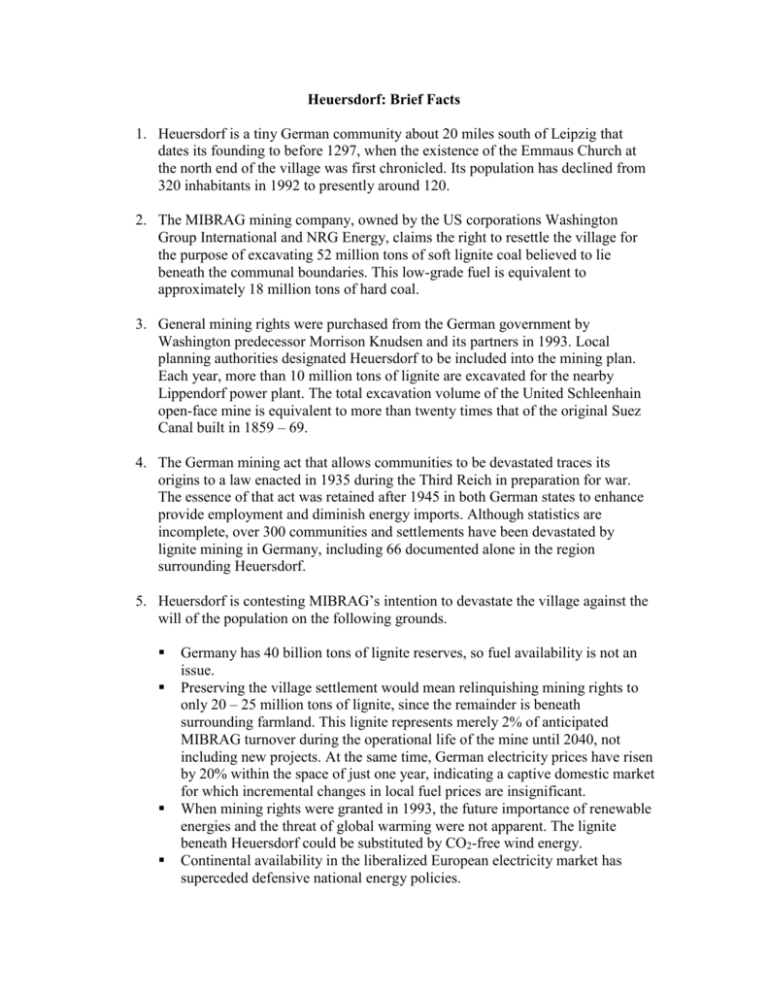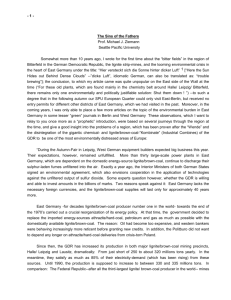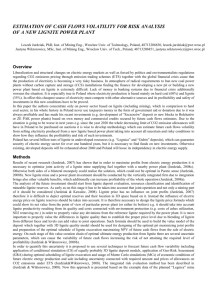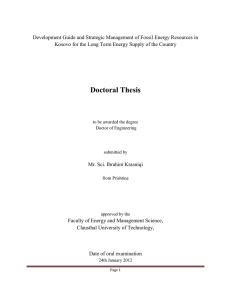Heuersdorf: Brief Facts
advertisement

Heuersdorf: Brief Facts 1. Heuersdorf is a tiny German community about 20 miles south of Leipzig that dates its founding to before 1297, when the existence of the Emmaus Church at the north end of the village was first chronicled. Its population has declined from 320 inhabitants in 1992 to presently around 120. 2. The MIBRAG mining company, owned by the US corporations Washington Group International and NRG Energy, claims the right to resettle the village for the purpose of excavating 52 million tons of soft lignite coal believed to lie beneath the communal boundaries. This low-grade fuel is equivalent to approximately 18 million tons of hard coal. 3. General mining rights were purchased from the German government by Washington predecessor Morrison Knudsen and its partners in 1993. Local planning authorities designated Heuersdorf to be included into the mining plan. Each year, more than 10 million tons of lignite are excavated for the nearby Lippendorf power plant. The total excavation volume of the United Schleenhain open-face mine is equivalent to more than twenty times that of the original Suez Canal built in 1859 – 69. 4. The German mining act that allows communities to be devastated traces its origins to a law enacted in 1935 during the Third Reich in preparation for war. The essence of that act was retained after 1945 in both German states to enhance provide employment and diminish energy imports. Although statistics are incomplete, over 300 communities and settlements have been devastated by lignite mining in Germany, including 66 documented alone in the region surrounding Heuersdorf. 5. Heuersdorf is contesting MIBRAG’s intention to devastate the village against the will of the population on the following grounds. Germany has 40 billion tons of lignite reserves, so fuel availability is not an issue. Preserving the village settlement would mean relinquishing mining rights to only 20 – 25 million tons of lignite, since the remainder is beneath surrounding farmland. This lignite represents merely 2% of anticipated MIBRAG turnover during the operational life of the mine until 2040, not including new projects. At the same time, German electricity prices have risen by 20% within the space of just one year, indicating a captive domestic market for which incremental changes in local fuel prices are insignificant. When mining rights were granted in 1993, the future importance of renewable energies and the threat of global warming were not apparent. The lignite beneath Heuersdorf could be substituted by CO2-free wind energy. Continental availability in the liberalized European electricity market has superceded defensive national energy policies. 6. A meeting with the villagers was called on August 19, 2004, by the local county commissioner, Petra Köpping, to present a concept for resettlement that has been endorsed by MIBRAG. Several Heuersdorf families intent on resettlement are said to have contributed their ideas in laying out the new subdivision in the neighboring town of Regis-Breitingen. MIBRAG has no plans to move any of the some 40 historic buildings, including the Emmaus Church and farmhouses built in the 18th and 19th centuries to this location. They would be irrevocably destroyed in the wake of resettlement. 7. Most of the villagers remaining, including all young families, are resolved to defend their Heuersdorf despite a resettlement law passed by the state legislature of Saxony in April 2004. The first such law was overturned in 2000. The Town Council is contesting the new law, as well. 8. Heuersdorf also overturned the regional mining plan in November 2003. The completion of a new plan is not expected until 2006. For the first time, an environmental impact study conforming with EU regulations must be included into the plan. Heuersdorf does not consider the ecological criteria prevailing in the mining industry to be adequate for insuring the environmental integrity of the project under the conditions of global warming, which is predicted to cause significant reductions of rainfall in the Leipzig region. Lignite mining necessitates depleting the water table to a level below the coal seams to permit the movement of heavy excavation equipment. 9. MIBRAG is pressing for short-term resettlement of the village and begin destruction of the buildings so that archeologists can examine the site as required by law before excavation begins in 2009. More than half the population has left Heuersdorf, taking advantage of resettlement premiums offered by the mining company. Possible motivations for this decision include the following: The standard resettlement premium of over 76,000 euro for homeowners cannot be bequeathed to heirs, so that elderly citizens may feel obligated to move in the interests of younger relatives before their death. Some families are interested in building a new house, but they have been forbidden to do so by state authorities within the town limits. They may be fearful that MIBRAG might ultimately withdraw the premium offer if Heuersdorf continued to resist devastation. The only certain means of receiving both fair market value for their home as well as the premium is to sell the property now to the mining company. 10. Considering the resistance of the remaining villagers, it is doubtful whether the population could be resettled within the intended time frame of less than a year. The mining equipment would ultimately have to move on and could only return at great cost, if indeed it were ever possible to evict the villagers. Forced eviction by specially trained border policemen would shed an ill light on Germany, which maintains world leadership in renewable energy technologies. 11. It therefore appears likely that MIBRAG will have to reach a compromise agreement with Heuersdorf. The company has stated repeatedly that such an arrangement would lead to its bankruptcy, despite the miniscule contribution of the Heuersdorf lignite to total turnover. In the case of insolvency, mining operations could be taken over by Vattenfall Europe, which operates the power station in Lippendorf and is also the largest mining company in eastern Germany. 12. MIBRAG’s attempt to devastate Heuersdorf ultimately reflects on the intended construction of its own 1000 MW lignite power plant in the region, for which extensive tracts of land and thus additional villages would have to be excavated. The realization of this project would be rendered more difficult by any legal precedent established by the successful opposition of Heuersdorf to established mining policy. Jeffrey H. Michel August 31, 2005








